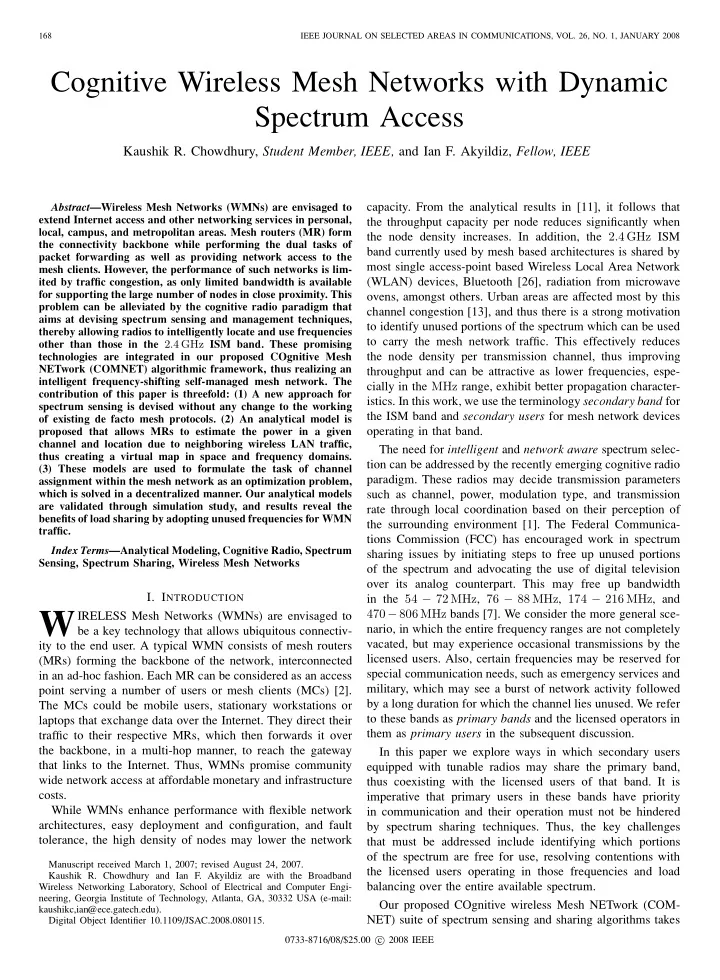

168 IEEE JOURNAL ON SELECTED AREAS IN COMMUNICATIONS, VOL. 26, NO. 1, JANUARY 2008 Cognitive Wireless Mesh Networks with Dynamic Spectrum Access Kaushik R. Chowdhury, Student Member, IEEE, and Ian F. Akyildiz, Fellow, IEEE capacity. From the analytical results in [11], it follows that Abstract —Wireless Mesh Networks (WMNs) are envisaged to extend Internet access and other networking services in personal, the throughput capacity per node reduces significantly when local, campus, and metropolitan areas. Mesh routers (MR) form the node density increases. In addition, the 2 . 4 GHz ISM the connectivity backbone while performing the dual tasks of band currently used by mesh based architectures is shared by packet forwarding as well as providing network access to the most single access-point based Wireless Local Area Network mesh clients. However, the performance of such networks is lim- ited by traffic congestion, as only limited bandwidth is available (WLAN) devices, Bluetooth [26], radiation from microwave for supporting the large number of nodes in close proximity. This ovens, amongst others. Urban areas are affected most by this problem can be alleviated by the cognitive radio paradigm that channel congestion [13], and thus there is a strong motivation aims at devising spectrum sensing and management techniques, to identify unused portions of the spectrum which can be used thereby allowing radios to intelligently locate and use frequencies to carry the mesh network traffic. This effectively reduces other than those in the 2 . 4 GHz ISM band. These promising the node density per transmission channel, thus improving technologies are integrated in our proposed COgnitive Mesh NETwork (COMNET) algorithmic framework, thus realizing an throughput and can be attractive as lower frequencies, espe- intelligent frequency-shifting self-managed mesh network. The cially in the MHz range, exhibit better propagation character- contribution of this paper is threefold: (1) A new approach for istics. In this work, we use the terminology secondary band for spectrum sensing is devised without any change to the working the ISM band and secondary users for mesh network devices of existing de facto mesh protocols. (2) An analytical model is operating in that band. proposed that allows MRs to estimate the power in a given channel and location due to neighboring wireless LAN traffic, The need for intelligent and network aware spectrum selec- thus creating a virtual map in space and frequency domains. tion can be addressed by the recently emerging cognitive radio (3) These models are used to formulate the task of channel paradigm. These radios may decide transmission parameters assignment within the mesh network as an optimization problem, which is solved in a decentralized manner. Our analytical models such as channel, power, modulation type, and transmission are validated through simulation study, and results reveal the rate through local coordination based on their perception of benefits of load sharing by adopting unused frequencies for WMN the surrounding environment [1]. The Federal Communica- traffic. tions Commission (FCC) has encouraged work in spectrum Index Terms —Analytical Modeling, Cognitive Radio, Spectrum sharing issues by initiating steps to free up unused portions Sensing, Spectrum Sharing, Wireless Mesh Networks of the spectrum and advocating the use of digital television over its analog counterpart. This may free up bandwidth I. I NTRODUCTION in the 54 − 72 MHz , 76 − 88 MHz , 174 − 216 MHz , and 470 − 806 MHz bands [7]. We consider the more general sce- W IRELESS Mesh Networks (WMNs) are envisaged to nario, in which the entire frequency ranges are not completely be a key technology that allows ubiquitous connectiv- vacated, but may experience occasional transmissions by the ity to the end user. A typical WMN consists of mesh routers licensed users. Also, certain frequencies may be reserved for (MRs) forming the backbone of the network, interconnected special communication needs, such as emergency services and in an ad-hoc fashion. Each MR can be considered as an access military, which may see a burst of network activity followed point serving a number of users or mesh clients (MCs) [2]. by a long duration for which the channel lies unused. We refer The MCs could be mobile users, stationary workstations or to these bands as primary bands and the licensed operators in laptops that exchange data over the Internet. They direct their them as primary users in the subsequent discussion. traffic to their respective MRs, which then forwards it over the backbone, in a multi-hop manner, to reach the gateway In this paper we explore ways in which secondary users that links to the Internet. Thus, WMNs promise community equipped with tunable radios may share the primary band, wide network access at affordable monetary and infrastructure thus coexisting with the licensed users of that band. It is costs. imperative that primary users in these bands have priority While WMNs enhance performance with flexible network in communication and their operation must not be hindered architectures, easy deployment and configuration, and fault by spectrum sharing techniques. Thus, the key challenges tolerance, the high density of nodes may lower the network that must be addressed include identifying which portions of the spectrum are free for use, resolving contentions with Manuscript received March 1, 2007; revised August 24, 2007. the licensed users operating in those frequencies and load Kaushik R. Chowdhury and Ian F. Akyildiz are with the Broadband balancing over the entire available spectrum. Wireless Networking Laboratory, School of Electrical and Computer Engi- neering, Georgia Institute of Technology, Atlanta, GA, 30332 USA (e-mail: Our proposed COgnitive wireless Mesh NETwork (COM- kaushikc,ian@ece.gatech.edu). NET) suite of spectrum sensing and sharing algorithms takes Digital Object Identifier 10.1109/JSAC.2008.080115. 0733-8716/08/$25.00 c � 2008 IEEE
Recommend
More recommend